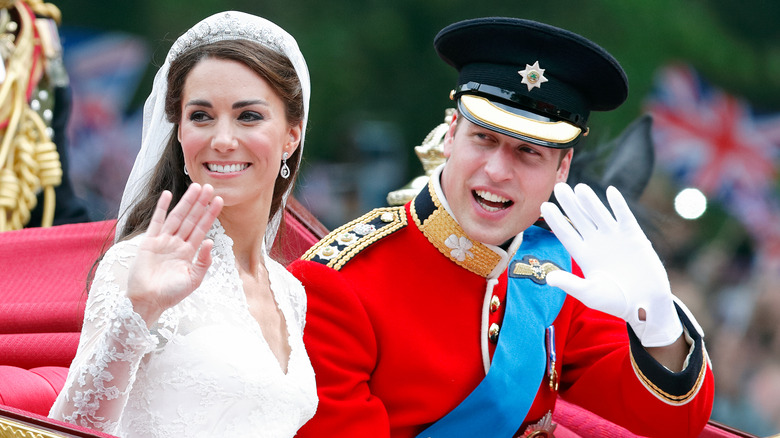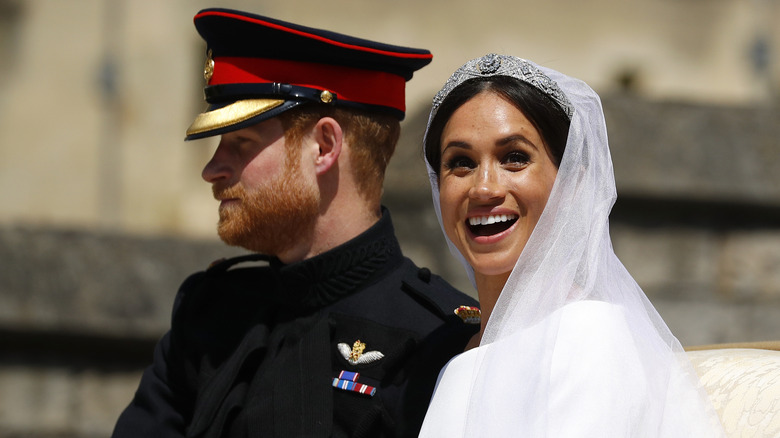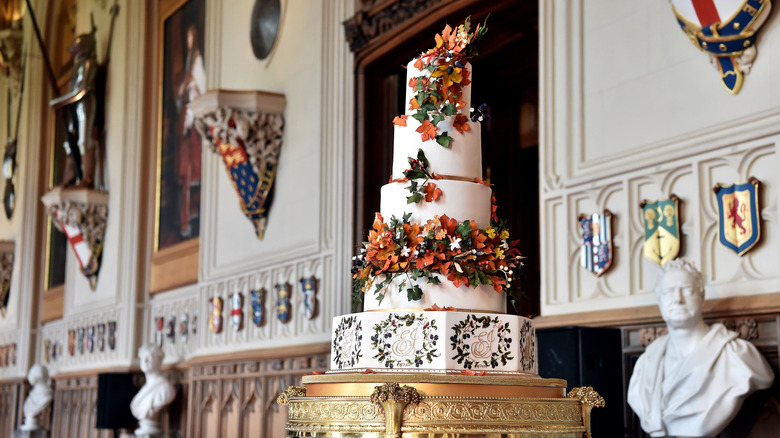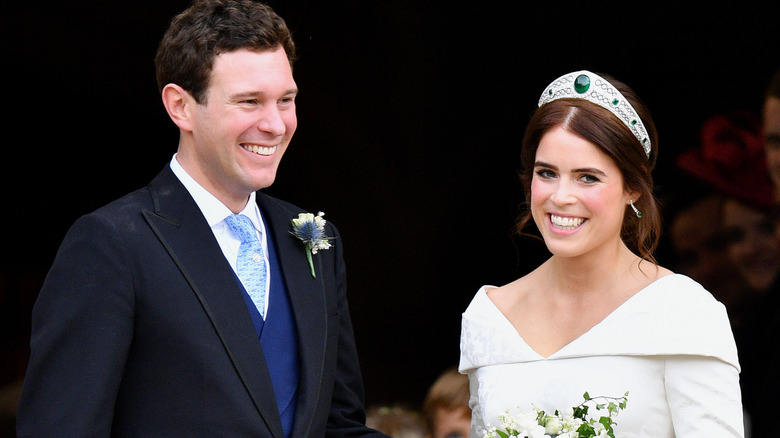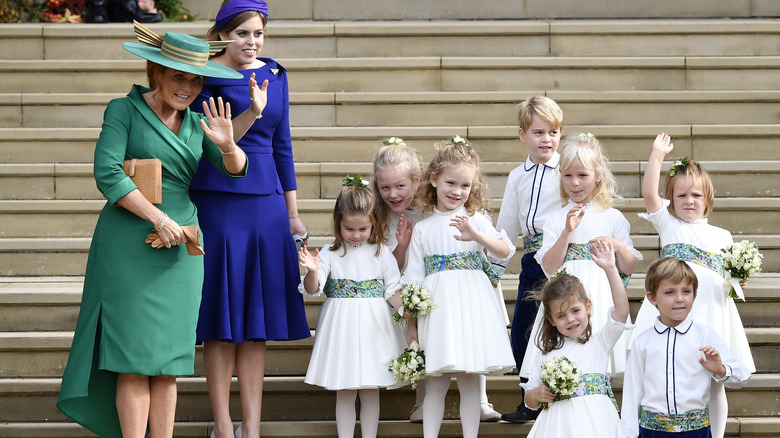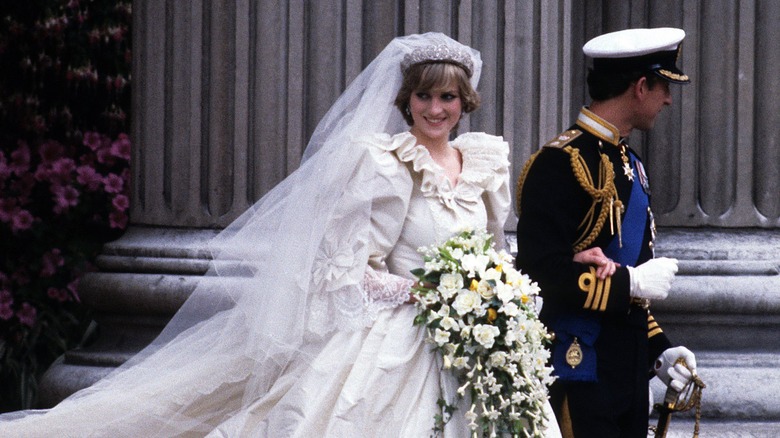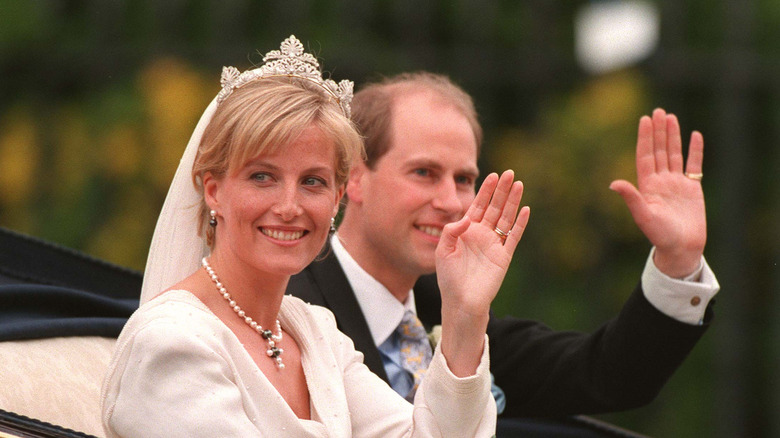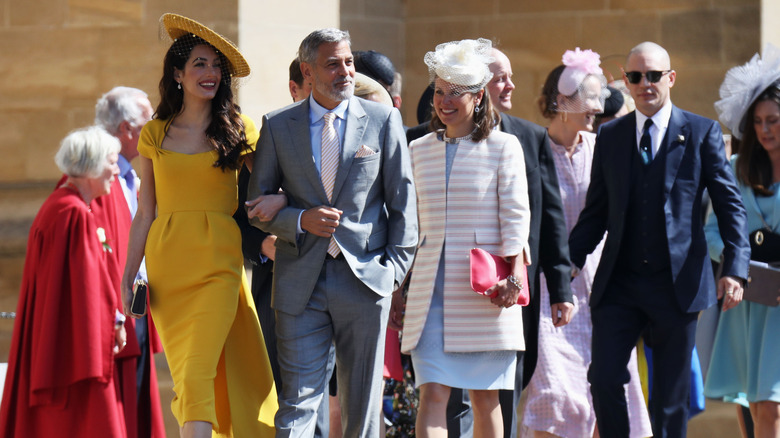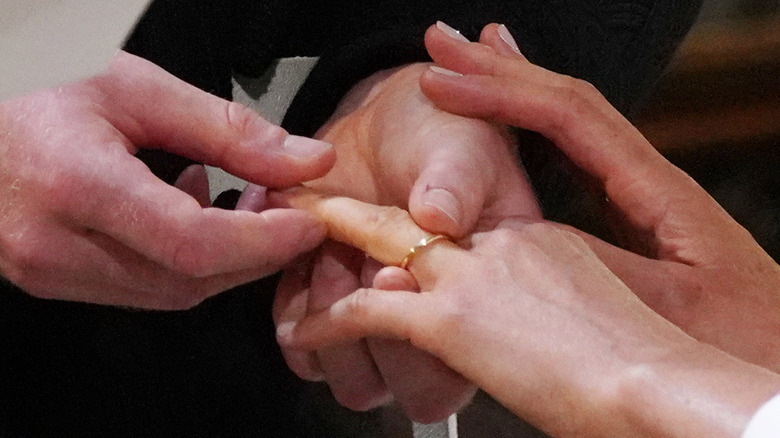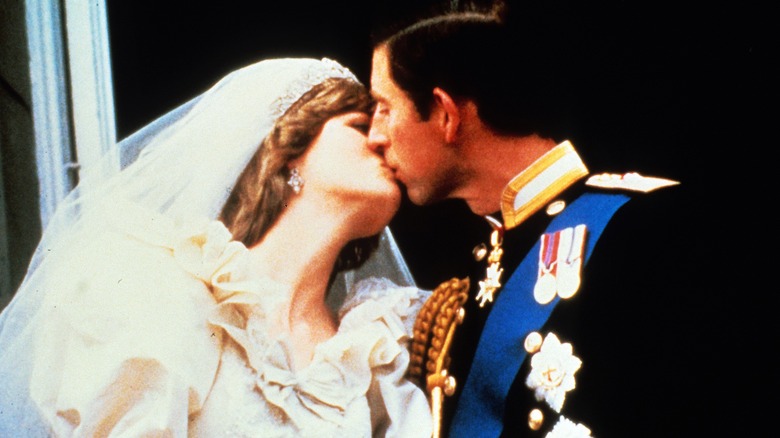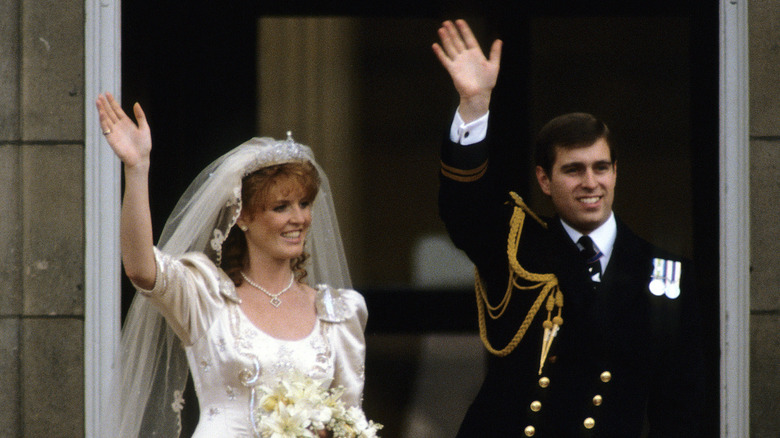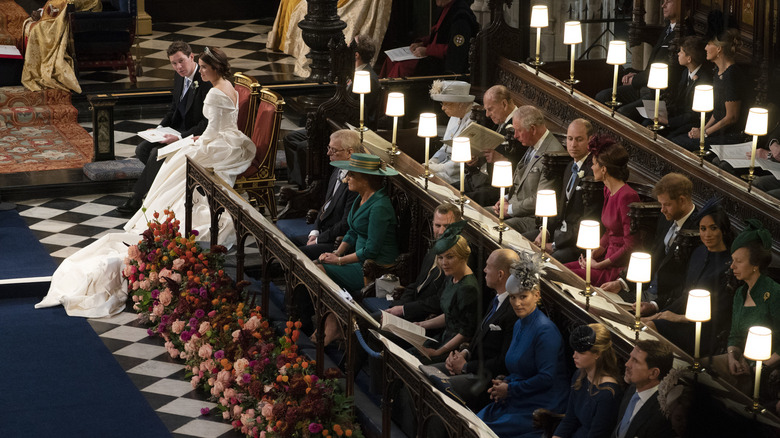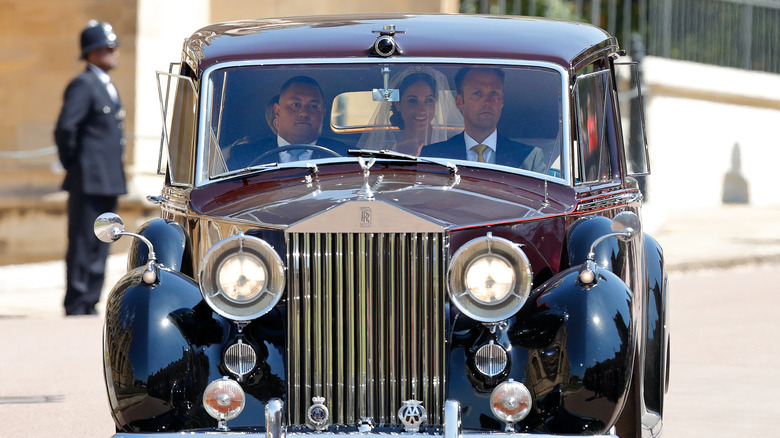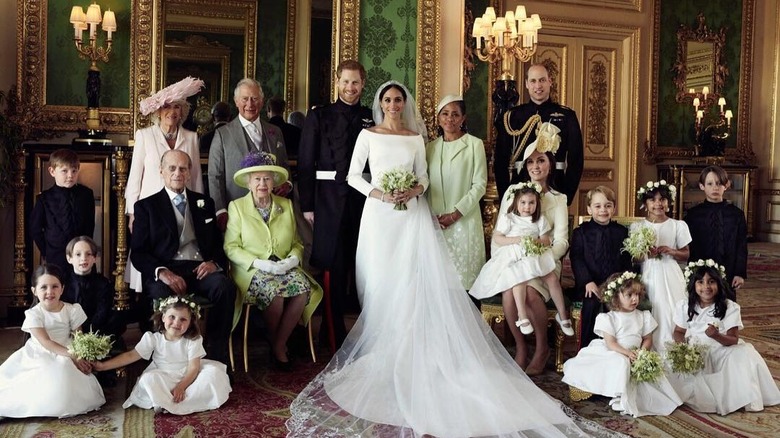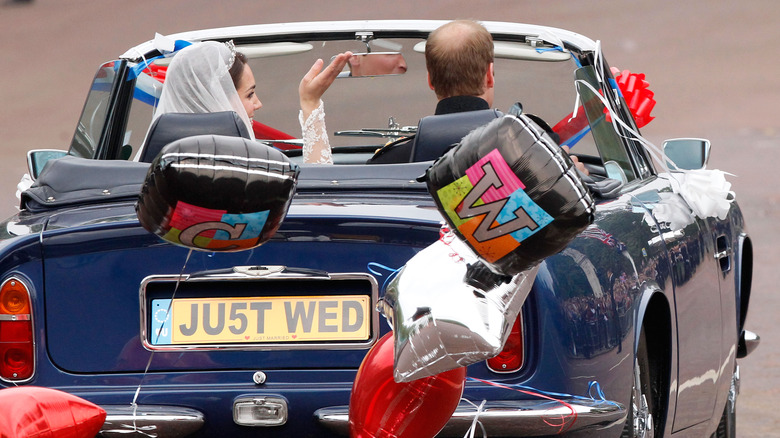14 Things That Happen At Every Royal Wedding
Everybody loves a good ol' wedding, especially one hosted by the world's richest. Royal weddings are global occasions. The coming together of two hearts in Britain is watched, attended, and celebrated by the masses every few years. It's a significant event — in fact, one that reportedly pumps £500 million (over $600 million) into the country's economy, according to Harper's Bazaar. Though the extravagance and pomp of royal weddings are certainly crowd-pullers, their importance is bolstered by much else.
"Still bound by protocol, tradition, and ceremony, royal weddings are really important to our sense of national pride," behavioral psychologist Jo Hemmings explained. As showcases of tradition, royal weddings have remained consistent regarding certain details over centuries now. A checklist of old-time customs, some even dating back to the 19th-century reign of Queen Victoria, is honored every time the British monarchy welcomes a new spouse into their fold. Here are 14 things that happen at every royal wedding.
The newlyweds are presented with extravagant gifts from across the world
There's nearly nothing one can gift the British royals that they won't already have, or be able to afford. So for moments like weddings where the custom of gift-giving is unavoidable, they often have to get creative. Prince William and Princess Catherine, for instance, urged people to consider charity donations instead of lavish wedding gifts sent directly to the happy couple. Prince Harry and Meghan Markle followed suit in 2018, with the caveat that people insistent on material gifting could have their tokens delivered to the royal residence. They did return favors by handing out goodie bags to guests at their wedding and, as per Reader's Digest, racked up a bill of over $9 million worth of gifting themselves.
Traditionally, jewelry has been a top gifting choice among and for royals. Queen Elizabeth II was the recipient of multiple precious jewelry pieces comprising diamonds, rubies, sapphires, and pearls gifted by the young bride's family. Prince Philip's gift was a sentimental gesture in the form of a self-designed bracelet made from diamonds borrowed from his mother's tiara. Per CNN, other presents that flew in from across the world included a wild and wonderful range of crystal candlesticks, carpets from India, tinned pineapples, and, sweetly enough, a live turkey all the way from a well-wisher in Brooklyn concerned about the queen's diet.
The wedding cake has to be of a particular kind
No wedding is complete without cake. And if you're ever at a royal wedding, it's no surprise that the cake will be as grand as the ceremony itself. Regular cakes wouldn't just pale in size compared to royal wedding cakes, but in weight too; per the Firm's own declaration, cakes have gone up to 200 kgs and beyond at royal nuptials. Fit for royalty, they rightly say. Designs and structures of royal wedding cakes vary across preferences, historically drawing inspiration from different eras of architecture for the detailing. Queen Victoria is largely credited with setting the trend of white wedding cakes in the 19th century — as she is for white wedding dresses.
While the extent of wedding cakes kept expanding with each royal wedding — Princess Diana and King Charles III reportedly laid out 23 at their ceremony! — some things rooted in custom have remained near-constant. For instance, the composition of this confectionary has traditionally always included fruit of some kind. Though Prince Harry and Meghan Markle diverged to opt for a contemporary lemon and elderflower flavor, a fruitcake base has the advantage of enduring the test of time. Given that it was likely preserved by alcohol when it was first served to guests in 1981, Diana and Charles' wedding cake has survived in slices that have gone up for auction more than once.
Not all royals require the monarch's approval before proposing
It may have been (slightly) embarrassing for the then-57-year-old Prince Charles to ask his mother's permission to marry the woman of his choice in 2005. But that's the way the cookie crumbles within the British monarchy. Certain members of the royal family immediately in the purview of the reigning royal head and ascendancy to the throne are obliged to get a formal nod from the monarch. It probably all sounds old-school; that's because it is. The mandate ties back to an Act passed by the British Parliament in 1772, which states: "No descendant of George II can marry without the consent of the reigning monarch."
So how did Princess Eugenie marry in 2018 without an official note of consent from Queen Elizabeth II? An amendment to the 18th-century rule exempted her. In 2013, the Parliament passed the Succession to the Crown Act which, besides removing the throne's male primogeniture bias, relaxed regulations around royal marriages. As mentioned in the official legislation, only the first six successors to the British throne are required to take the monarch's permission before marrying. Since Prince Harry was among the top few in the line of succession at the time of his marriage to Meghan Markle, his grandmother officially blessed the match before the nuptials proceeded.
The bride's wedding party is an all-kids zone
The littlest royal family members are given big roles to play on the wedding day. While looking adorable is job number one, the youngest kin of the happy couple are also tasked with accompanying the bride down the aisle on her big day. Needless to say, the bride's wedding party livens up the ceremony and often leads to impromptu amusement. At Meghan Markle's wedding in 2018, Prince George and Princess Charlotte were respectively page boy and flower girl-in-chief. But it was page boy Brian Mulroney, the son of Meghan's best friend, who photobombed the bride with an overjoyed grin and stole the show.
The bridal party is a merry, responsible little bunch that turns up dressed in matching outfits and fulfills its role of sprinkling flowers and holding up the bride's veil dutifully. That said, it can often be a herculean task to get the kiddies to stand still for portraits. But there's nothing good ol' candy can't do. As royal wedding photographer Alexi Lubomirski shared with ABC News Australia, his team had stocked up their arsenal with candy. "As soon as the kids came onto the set, I immediately just shouted out 'Who likes Smarties?' and then everybody, hands up, smiles, even some adults put their hands up," Lubomirski recalled.
All royal bouquets contain this particular special flower
Like several other wedding traditions she inaugurated, Queen Victoria also kickstarted the custom of adding a sprig of myrtle to the bridal bouquet. The floral bunch could comprise orchids or roses or lilacs but somewhere inside the posy will always lie a delicate, white sprinkle of fragrant myrtle. The plant has been around since time immemorial, finding popularity in ancient Greece, in religious and ceremonial contexts, per the National Records of Scotland. It's hailed as an everlasting symbol of love, which makes it quite a proper fit in a bridal bouquet.
Historically, the myrtle that found its way into royal wedding bouquets came from a plant that adorned the gardens of Victoria's 19th-century royal residence in Osborne, Isle of Wight. When her daughter tied the knot in 1858, the queen oversaw the addition of myrtle to her nosegay. "It's a German tradition that signifies the innocence of the bride," Toby Beasley, head gardener at the royal estate in Osborne, was quoted by English Heritage as saying. The wedding custom Victoria established is still around among the British royals, as is the family of the original myrtle plant that started it all in Osborne.
Both the royal bride and groom's wardrobes are governed by rules
As the stars of the show, the bride and groom are expected to be particularly heedful of tradition when picking out their D-day fineries. Male members of the royal family who have served in the forces bring out their military uniforms and decorations, though it seems that the monarch can exercise some authority over the groom's wedding outfit, as Queen Elizabeth II did for her grandsons Princes Harry and William. While Harry had to seek permission from the late queen to wear his Blues and Royals frockcoat (per a royal statement), he revealed in his memoir "Spare" that the queen rejected his brother's request to wear his Household Cavalry kit and urged him to go for his Colonel of the Irish Guards uniform (via Independent).
Among the most famous diktats regarding the bride's wedding gown, which Meghan Markle infamously challenged, was the no-shoulder-show rule. In keeping with royal and religious sensibilities, the bridal gown should also preferably be long-sleeved, though younger royals like Princess Beatrice have passed over this code in recent times. "You won't see cleavage. You won't see a lot of skin. ... It would be seen as disrespectful," etiquette expert Myka Meier told The Columbus Dispatch. It's probably a no-brainer but brides too, need the monarch's stamp of approval on their attire. And, like other things on exhibition at a British royal wedding, the couple's outfits must ideally be tailored by domestic designers.
Even guests dress according to strict royal protocol
If the bride and groom dress according to protocol at a royal wedding, one can only deduce that wedding guests too, will be circumscribed by certain sartorial rules. For starters, the codes of propriety that apply to a bride are also extended to female guests in attendance: no visible shoulders, no thigh-baring dresses, no excessive skin show. The prescribed attire for women, as mentioned in Meghan Markle and Prince Harry's wedding invitation, is a day dress with a hat. The latter is non-negotiable — "You can't go to a royal wedding without a hat," milliner Louise Green told ET – and, over the years, royal weddings have gained repute as an animated exhibition of headdresses.
The bottom line is that (like handbags) hats and fascinators shouldn't be colossal so as to avoid obstructions for other attendees at the ceremony. Per ABC News, anything too frilly or unfashionable is also discouraged. Basically, looking tacky is a no-no. For male attendees, meanwhile, the dress code is fairly straightforward with options between morning coats or lounge suits. Men who have served in the military can choose to wear their uniforms. Looking dapper is the goal.
Royal wedding rings are forged from very rare gold
Like most of the kingdom, royals don't have the liberty of walking into any odd jewelry store and picking out the glitziest ring to slip onto their partner's finger. Royal rings decidedly have a special quality that sets them apart from their common counterparts: hints of very rare Welsh gold. The tradition goes back a century, dating to the wedding of Elizabeth Bowes Lyon and King George VI in 1923. The gold came from the Clogau house, the name behind the rich reserves of gold in Bontddu, North Wales. According to Clogau's website, all their jewelry incorporates Welsh gold, whose authenticity is determined most distinctly by the Welsh dragon stamp.
The brand has come to be identified most deeply with the British monarchy and, as a spokesperson told People, "We get a lot of exposure when there is a royal wedding." The custom started by the Queen Mother was honored by her lineage, right from Queen Elizabeth II in 1947 to Meghan Markle in 2018. Clogau's protracted association with the royals goes beyond weddings though.
In 1986, Clogau presented Elizabeth with a precious kilogram of Welsh gold to mark her 60th birthday. Bethany Fenn, who works closely with the gold mining industry in Wales, told CBS News that the British royals are among an elite group with access to Welsh gold reserves and the nugget in their possession has likely been the source of wedding rings since the 20th century.
The iconic balcony kiss tradition is not that old
The royal couple emerging from their ceremony to share that fabled balcony smooch has become one of the most-anticipated bits of royal weddings over the years. The customary feel of the practice hardly betrays the fact that the tradition isn't all that old among the British royals. In fact, if the lore is to be believed, the now-iconic royal wedding balcony kiss first came about as an unplanned event. From Princess Diana's crumpled gown to King Charles III's botched-up vows, there was plenty that didn't go seamlessly on their wedding day. It seems the groom had also overlooked the ritual of kissing his bride at the altar when they said "I do," The New York Times reported at the time.
It was when they greeted a sea of 600,000-strong spectators outside Buckingham Palace as husband and wife that Charles sealed his union with Diana by sharing a public kiss. The crowd obviously went wild. Victorian mores wouldn't historically have been in agreement with members of the British royalty displaying public intimacy. Charles and Diana broke the spell, initiating a new observance that has since been honored by many other royal couples, including Diana and Charles' sons Princes William and Harry — though the latter didn't wait to get to the palace, instead kissing Meghan Markle right outside the chapel.
The bride typically wears a tiara for the first time on her wedding day
One of the most dazzling bits of a royal bride's couture is the tiara adorning her head. The definitive regalia for a princess, a tiara is an integral part of bridal attire, and wearing one has been a time-honored tradition among Britain's royal brides (at least since The Queen Mother's wedding in 1923). Priceless, antique headpieces have been brought out of palace coffers to deck up the women already part of the royal family or the ones who join it by marriage. Typically, her wedding day is when a woman wears a tiara for the first time. "Tiaras in particular have been a way of kind of marking a royal woman's entry into royal life and adult life," royal curator Claudia Acott Williams told Town & Country.
Royal wedding tiaras are stately symbols of royal inheritances and manifestations of the romantic tradition of "something borrowed" that brides observe. The Fringe Tiara Queen Elizabeth II donned at her nuptials in 1947 was handed down to her by her grandmother Queen Mary, for whom it was commissioned by Garrard. According to the jewelry house, the tiara has been beloved by five generations of the royal family, with the late queen loaning it to Princess Beatrice for her wedding in 2020. Borrowing from the royal vaults is not necessary though. Princess Diana memorably carried a piece of her own family's heritage by wearing the Spencer Tiara at her wedding.
A seating plan is meticulously drawn out with an exclusive place for royals
Royal weddings don't offer first come first serve seating, as you may have guessed. Like everything else about royal events, a seating plan too, is meticulously drawn out in advance of a wedding. There are two major sections along which guests are seated during a chapel ceremony: the quire and the nave. The quire, closest to the bride and groom, is where the closest family and friends of the happy couple sit. The groom's side is traditionally assigned the right side, while the bride's family sits to her left. Senior royals are given great seats, though it's not a compulsion to assign a front-row seat to the monarch; important dignitaries and VIP personages also have frontline seats to the right, per CNN.
The bulk of other guests fills up the rest of the benches in the chapel all the way back to the nave on both sides of the aisle. Royal expert Alastair Bruce told Town & Country that the seating plan at royal weddings isn't as taxing as it sounds and the bride and groom have relative autonomy over who gets the best view of their nuptials (hopefully without snubbing or upsetting others). The Lord Chamberlain's Office presides over the setup and is free to advise the royal family on the seating chart. "They know the layout of St. George's Chapel, and they will guide [the groom]," Bruce said at the time of Prince Harry's wedding.
Luxury is on full display with top-end wedding cars
If one didn't know any better, royal weddings could well pass off as luxury auto-expos. Consistent with the extravagant wealth royal weddings showcase, the vehicles — in particular those transporting the bride and groom around — are lavish carriers flaunting some of the auto world's most expensive logos. Meghan Markle's wedding in 2018 could have easily been a motorhead's dream. The bride rolled up in a limited edition Rolls-Royce Phantom IV and zoomed out of Windsor Castle with her better half in a Jaguar E-Type Zero. Aston Martins and Bentleys have also previously made appearances, symbolizing homegrown British pride.
From opulent horse-pulled carriages to the hottest modern wheels, royal wedding cars have traveled far down the road. Proving that these mean machines are absolute show-stealers at stately nuptials, the vintage Jaguar model that carried Harry and Meghan became so popular that the company decided to put a refurbished make of the car on the market, Bloomberg reported. The price tag was projected to be in the royal range of $500,000. Parallel to the element of inherited prosperity, royal cars are also often tokens of sentiment. Meghan's Rolls-Royce, for instance, was one borrowed from the monarch's fleet and has been a beloved piece in the royal family.
The bride and groom pose for official wedding portraits with the family
The British royals are not immune to the everyman impulse of clicking loads and loads of pictures at a wedding. And family portraits make up some of the most special, star-studded snaps in the wedding album. Typically, the official family picture features all the key players of the monarchy — all the way from the reigning monarch right down to the youngest kin of the bride and groom. The newlyweds are placed front and center, while their respective families each take one side flanking the happy couple. Royal expert journalist Duncan Larcombe told Harper's Bazaar that the agency of positioning each member for the wedding portraits is largely left to the photographer.
While Queen Elizabeth II, King Charles III, and Prince William's wedding portraits followed a similar pattern — all were clicked at Buckingham Palace's Throne Room and had an orderly placement — Prince Harry and Meghan Markle's big family picture broke away from the norm. Their portrait was shot in the Green Drawing Room of Windsor Castle, where baby Harry was photographed after his christening in 1984, as was his son Archie years later in 2019. Another distinct feature was the lack of family members from Meghan's side, besides her mother.
The religious ceremony is followed by a fun reception
After the solemn rituals are done and dusted, the newlywed royal couple buckles up in a fancy getaway car bound for an evening of unfettered, unabridged merrymaking. The wedding reception is a relatively informal affair made of cocktail and food binges — an event where the happy couple and their guests can finally let their hair down (within limit, of course). The guest list for the reception is short and exclusive, with A-list attendees partaking in revelries that range from dance-offs to beer pong, Vanity Fair observed.
Though seniormost adults, including the monarch, mark their presence at the reception, they wind up earlier than others and "leave the young ones to it," as King Charles III and Queen Camilla did at Prince Harry's wedding afterparty. With George Clooney shaking a leg and Idris Elba deejaying, that party was a sure hit. Princess Eugenie's reception was not any less fun, comprising carnival activities and classic fairground foods, a source told The Times. Besides the lively entertainment, the reception also has emotions running high with heartfelt speeches by the bride and groom, as well as their friends and family.
